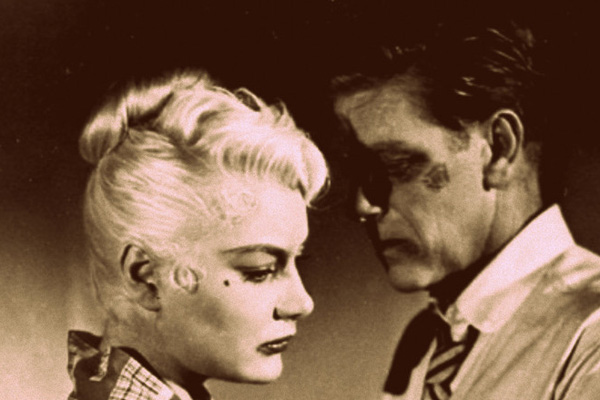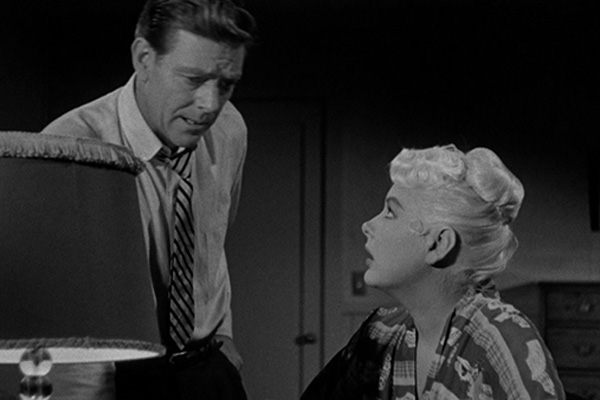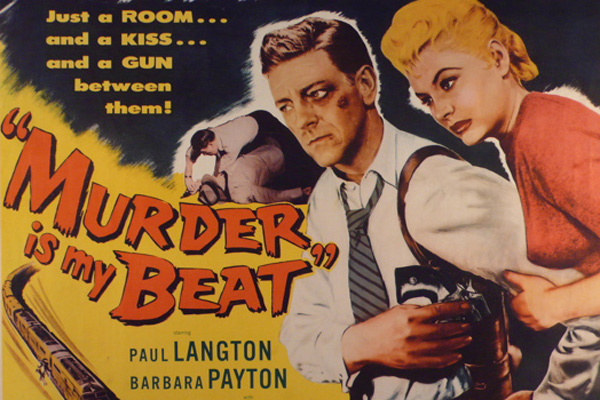A Last Gasp of Stale Air
This essay is adapted from the book Edgar
G. Ulmer: A Filmmaker at the Margins, due
out from University of California Press early next year.
“Somehow even mediocrity can become
majestic when it is coupled with death.” —Andrew Sarris
After directing a few generally unnoticed pictures abroad, including the
Italian production I Pirati di Capri (Pirates of Capri, 1949) and the
Spanish-English co-production Muchachas
de Bagdad (Babes in Bagdad, 1952),
and continuing to work as a freelancer, Edgar G. Ulmer returned to the terrain
of American hard-boiled noir one last time. His agent and friend Ilse Lahn, a fellow
transplant from Vienna who worked for the Paul Kohner Agency—which represented
among other émigré filmmakers Billy Wilder, Erich von Stroheim, and Fred
Zinnemann—came to him with a project called The
Long Chance (what would ultimately acquire the release title Murder Is My Beat). In a letter of 14
February 1954, soon after the script had been vetted and approved by Joseph I.
Breen’s office, Ulmer informed his daughter Arianné that he was busy scouting
locations for the production, which was scheduled to begin shooting that April.
At the time, he and his wife Shirley were living in a rental apartment on
Fountain Avenue in Hollywood, not terribly far from Universal and other
lower-rung studios, where he’d once worked. It had been a welcome return for
both of them, having bounced around Europe for several years battling recurrent
loneliness and feelings of marginalization. Ulmer especially embraced the
opportunity to work again in America, which by then, despite some of the recent
political turmoil, he regarded as his true home.
Scripted by the British writer Aubrey Wisberg, who had co-written Ulmer’s Man From Planet X with Jack Pollexfen a
few years before, and co-produced by Lahn and Wisberg for Masthead Productions
as an Allied Artists release, Murder Is
My Beat—finally issued on DVD this past January from the Warner Archive
Collection—is another case in Ulmer’s career of work done on the fly. Owing in
part to the vertiginous nature of the story confected by Wisberg and Martin
Field and to the elliptical editing undertaken by Ulmer and Fred Feitshans, Jr.
(who, like Wisberg, had worked with him on Man
from Planet X), the film often feels unmoored, almost unfinished, given
over more to atmosphere and emotion than to narrative coherence. “Ulmer
introduces us to situations and characters without warning,” observes John
Belton. “The frequency and consistency of his narrative lapses give them
thematic significance: whether it is intentional or not, Ulmer’s narrative
discontinuity becomes symbolic of the forces of disorder and destruction that
dominate his artistic universe.” Like Detour,
the film exudes an air of rawness, its players and settings notably gruff and
downtrodden, a relatively accurate reflection of the bargain-basement
production.

Murder Is My Beat
As in the case of his other two better-known noirs, Detour and Ruthless, Murder Is My Beat takes shape more or
less via flashback narration. The film opens with a sedan careening down a
California highway bathed in sunlight, the man at the wheel exhibiting a look
of dogged determination—the strains of Al Glasser’s modest score helping to highlight
the initial suspense—as he turns into a roadside motel. He exits the car and
snakes his way around several motel cabins before sidling up to the one he’s
looking for, ducking under the window to make sure he’s not noticed. Inside,
viewed furtively through the cabin window shot from outside, Detective Ray
Patrick (Paul Langton) lies on his back, eyes glazed over in a state of
apparent resignation, staring up at the ceiling. The pose he strikes vaguely
recalls one struck by Burt Lancaster’s Ole “Swede” Andersen near the start of
Robert Siodmak’s The Killers (1946),
moments before his door is kicked in, which is precisely what occurs here.
Instead of being gunned down, though, Patrick leaps up and tackles his
assailant, who after a few awkward, clumsy blows is recognizable as his boss in
the Los Angeles Homicide Division, Captain Bert Rawley (Robert Shayne). As it
turns out, Rawley has been chasing down Patrick ever since he and Eden Lane
(Barbara Payton) jumped from the train that was to bring Lane to a prison
upstate. There she was to serve a sentence for the murder of a man known as
Frank Dean, a man with whom she allegedly had been having an adulterous affair
and who was found lying headfirst in his own fireplace, face and hands charred
beyond recognition.
Despite Rawley’s insistence on taking Patrick back with him to Los Angeles in
cuffs, and despite his firm belief that one of his “best men” was played for a
sucker, Patrick manages to persuade his boss to listen to his story which,
unsurprisingly, is when Ulmer rolls out his flashback told in voiceover
narration. Detective Patrick explains things from the very beginning, from the
first moment that he showed up at the scene of the crime (i.e., when he was
still the “level-headed, on-the-job, no-fancy-frills, straight-shooting cop”
that Rawley took him to be when he assigned him to the case) to the burgeoning
sense of doubt with respect to Lane’s supposed guilt (i.e., when Patrick begins
to feel as if he were “coming apart at the seams”) and his ultimate decision to
take “the long chance” of the film’s working title—which is to say, to take the
law into his own hands.

Murder Is My Beat
Along the way, we are given a tour of the inscrutable world of Eden Lane: we
meet Patsy Flint (Tracy Roberts), Lane’s shifty, tight-lipped roommate at “The
Spotlight” nightclub, where Lane sings and where Flint works as a “picture
snatcher” (her chief occupation, we later learn, is blackmail); we get a quick
look at Flint and Lane’s cluttered apartment and a few clues suggesting Lane’s
hurried departure on a Greyhound bus bound for Northern California; we then
follow Detective Patrick who, after trudging up a snow-covered mountain, finds
his catch holed up in a chalet in the Sierras, on the lam but looking
deceptively innocent (“all sweetness,” as he puts it, “but the most dangerous
type at that”); and finally, we witness Patrick becoming more and more smitten
with the very woman he’s sent to arrest for murder, from their first cigarette
to their dramatic leap from the moving train, after Lane claims to have seen
Frank Dean on the platform of a station they passed. Viewed in the wider
context of film noir, Patrick shares some of the same susceptibilities that
undercut the otherwise steely, rugged exterior of Detective Mark McPherson
(Dana Andrews) in Otto Preminger’s far more polished and generously bankrolled Laura (1944). They both exhibit a
near-pathological faith in the innocence of a woman who is taken, at least
fleetingly, to be a murderess. Moreover, they both show a willingness to ignore
the rule of law in favor of their own vigilante pursuit of love.
At the very moment that Patrick has his story
loop back to the original point at which Rawley entered the scene, Ulmer
returns things to the present. With some additional coaxing, Patrick convinces
his boss to give him another 24 hours and to lend a hand in finding the true
murderer. Working as a team, they discover that Frank Dean was merely an alias
for a married man named Abbott (Roy Gordon), the owner of a ceramics factory in
the small Northern Californian town in which Patrick and Lane fatefully find
themselves after jumping from the prison-bound train. Rawley and Patrick hunt
down Abbott, squeezing a confession out of him. In the film’s penultimate
scene, caught on a train leaving town with his wife, Abbot admits that while
having an affair with Lane, he was blackmailed by a private investigator, the
man he killed and left for dead in his fireplace (the investigator, we learn,
was romantically involved with Patsy Flint, who continues the extortion
efforts). By the close, all loose ends are essentially tied up, and Patrick, in
the ill-conceived, incommensurately sentimental final scene of the film, is
free to marry Eden Lane, now proven innocent, with Rawley as his best man.
In terms of its generic trappings, Murder
Is My Beat oscillates between noir, the police procedural and, as one
critic has recently put it, a “rather ordinary whodunit.” Given its limited
means, it isn’t long on style, has minimal camerawork, and essentially gets by on
its canny use of mirrors, stock footage, and rear projection. But the basic
mood of the film conveys the same social disillusionment encountered elsewhere
in other bleak pictures of the period. The specter of war, though slowly
beginning to recede on the horizon by the mid-1950s, is still eminently
palpable in Murder Is My Beat.
Detective Patrick’s moral compass, which we know from the world of noir is
always in danger of being compromised, is guided by his wartime experience.
“I’d seen too much killing in the Pacific,” he announces while wading through
the deep snowbanks in pursuit of Lane. Much like Al Roberts—and of course
countless other noir antiheroes—he is adrift in the world, taking each blow as
it’s dealt. And like Roberts, he ultimately accepts his fate, inauspicious as
it may be. The final line of his flashback narration evokes a similar sense of
ensnarement: “now I knew I was licked.” Similarly, Ulmer takes up the vexed
issue of class—those who have it and those who don’t—once more with this film.
Indeed, Mr. Abbott’s extramarital affair with the much younger nightclub singer
Eden Lane is a form of social slumming for the factory owner, a way for him to
indulge anonymously in the vices of big-city life. And as we observe further in
the plot’s unfolding, Mrs. Abbott (Selena Royle) comes from an unusually
affluent, well-established family—the ceramics factory belongs to her—which
makes the final charges of blackmail, those leveled against her and her husband
by the conniving, déclassé Patsy Flint, all the more menacing. Mrs. Abbott
would rather commit suicide, as she does in the end, than have her family name
dragged through the mud.
If there is one thing that elevates the film, however, it’s Barbara Payton’s
performance as Eden Lane. Having reached the pinnacle of her career playing
opposite James Cagney in Kiss Tomorrow
Goodbye (1950), only to then suffer from a pileup of scandals onscreen and
off, Payton brought a degree of human vulnerability to the lead part, her last.
Even if she’s missing the high-octane verve of Ann Savage’s Vera, Payton’s Eden
Lane, dressed in her form-fitting sweaters, with her platinum blonde hair and
thick, glistening lipstick of a 1950s pinup girl, helps get the film up on its
feet. “It may lack the classic dimensions of . . . Detour,” suggest film noir historians Bob Porfirio and Alain
Silver, “but benefits from the presence of Barbara Payton as an ambiguous femme fatale. Ulmer extracts the maximum
narrative tension from the viewer’s uncertainty over Eden Lane’s guilt, an
uncertainty reinforced by Payton’s portrayal of Eden in a ‘neutral’ manner.”
From the moment we first meet her, sequestered in the mountain chalet looking
pouty and forlorn but not entirely culpable, there is a magnetism that draws in
the viewer and that propels the film. It doesn’t take long for Ray Patrick, and
the audience with him, to fall for Eden, to believe her sighting of Frank
Dean—what initially seems sure to be a mere MacGuffin—and to maintain an
abiding faith in the distraught nightclub singer. Playing against type, she’d
rather turn herself in for a crime she didn’t commit than to have Detective
Patrick jeopardize his career for his indiscretions.

Film poster for Murder Is My Beat
Although review attention at the time of the film’s release, in the final days
of February 1955, was scant—and what did appear was uneven at best, with
Ulmer’s direction called “well-paced” in one trade paper, but considered run of
mill elsewhere, i.e., “[direction of a] standard thriller in standard
style”—Milton Luban’s evaluation in the Hollywood
Reporter declared, “Miss Payton is excellent as the wrongfully convicted
girl.” As a side note, Luban found it fully within his rights as critic to
offer his view of Payton’s putatively expanding figure: “she is getting a bit
too buxom.” Of course, the film—from the script to casting to wardrobe,
lighting, cinematography and direction—no doubt played up this aspect,
following the logic of exploitation, in the hope of box-office appeal. Early on
in Patrick’s flashback, after arriving at the crime scene, Frank Dean’s
neighbor Miss Sparrow (Kate MacKenna) recounts that Miss Lane “wore tight
clothes [that] in an indecent way showed her shape” and that even her name
“reminded you of original sin.” When co-producer Ilse Lahn first supplied
Joseph Breen with a copy of the script in January 1954, he flagged any and all
suggestive bits (repeating the same canned language on the need to cover all
body parts, specifically in the case of “the negligee worn by Eden”). It had to
be clear, moreover, that Eden was not a prostitute. This was true of Patsy
Flint as well. In the film, she is referred to as a “picture snatcher,” not to
be confused with “middle-aged hustler,” as the scenario in the script initially
had it—a red flag for Mr. Breen’s office—but whose wardrobe, body movements and
gestures, after the shooting was complete, might suggest otherwise. As in Detour, Ulmer ultimately appears to have
had a fair degree of wiggle room when it came to sexually charged banter (e.g.,
the flirtatious exchange between Patsy and Detective Patrick in her apartment)
and racy innuendo.
Part
of the attraction of a film like Murder
Is My Beat—not altogether unlike that of Detour—is the visual pleasure taken in its imperfections and its
flagrant violations of Hollywood studio conventions. It requires a certain
appreciation of the so-called “spirit
of poverty,” or what Antoine Rakovsky calls “l’esthetique
du ‘cheap’,” of
under-budgeted, minimalist filmmaking in
extremis. By the time the initial enthusiasm for film noir, expressed by
French cineastes and the auteur-focused critics of Cahiers du cinéma, had made its way across the Atlantic, such films
as Detour, Ruthless, and Murder Is My Beat had found a new
audience. Replicating the efforts of the French Cahiers crowd, American art-house moviegoers and critics of the
late 1960s and 70s took great pains to find virtues, even poetry, in the
neglected, depraved, misunderstood independent pictures made on the fringes of
Hollywood. Following such an approach, it was now possible, to paraphrase
Andrew Sarris, to perceive the “mediocrity” of a second-bill crime picture as
something truly “majestic.” Or, as James Naremore notes in his magisterial
study of film noir, More Than Night, the
American counter-cultural scene at the time was particularly receptive to such
impoverished productions: “Critical commentary circulated through alternative
newspapers and campus journals, and from the beginning, aficionados lavished
special praise on B movies or slightly pulpish genre films. It was hip, for
instance, to prefer Murder Is My Beat
over The Maltese Falcon, or to argue
that Touch of Evil was a better movie
than Citizen Cane.” In this climate,
driven at the beginning perhaps merely by a compensatory or contrarian impulse
toward hipness, a director like Ulmer would achieve a new wave of recognition,
one that was built in no small measure around the appreciation of his work in
film noir.
![]()
LATEST ARTICLES
-20140814-173707-thumb3.jpg)
Fighting Words
by Imogen Sara Smith
posted August 12, 2014

Fighting Words, Part 2
by Imogen Sara Smith
posted August 20, 2014

On the Margins: The Fil…
by Andrew Chan
posted August 12, 2014

Robin Williams: A Sense…
by David Schwartz
posted August 12, 2014
 A Last Gasp of Stale Air
A Last Gasp of Stale Air
THE AUTHOR
Noah Isenberg directs the Screen Studies program at Eugene Lang College – The New School for Liberal Arts, edits the review section at Film Quarterly, and is the author of, among other books, Detour (BFI Film Classics, 2008).
More articles by Noah Isenberg
